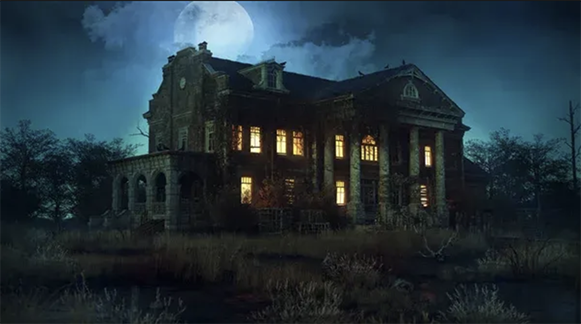Gothic Giants: Contrasting Shadows of The Haunting of Hill House and Hell House
The haunted house is a time-honored trope in horror literature. Two of the most iconic stories in this subgenre are Shirley Jackson’s The Haunting of Hill House (1959) and Richard Matheson’s Hell House (1971). Both novels have left an indelible mark on the genre but do so in strikingly different ways. While they share the basic premise of a haunted house that preys on its inhabitants’ weaknesses, the two novels diverge in tone, style, and the nature of their horror.
Masters of Horror: The Minds Behind Hill House and Hell House
An influential American author, Shirley Jackson is best known for her chilling short story The Lottery (1948) and her novel The Haunting of Hill House. Her work often explores the darker aspects of human nature and the macabre undercurrents of everyday life. Jackson’s writing has influenced numerous authors, including Stephen King, who has cited The Haunting of Hill House as one of the finest horror novels of the 20th century. Jackson’s nuanced approach to horror often blurs the line between psychological and supernatural elements, leaving readers questioning what is real and imagined.
Richard Matheson, an American author and screenwriter, is known for his science fiction, horror, and fantasy work. Matheson’s influence extends across literature, film, and television, with works like I Am Legend and The Shrinking Man solidifying his reputation as a master of speculative fiction. Hell House, one of his most famous novels, is a relentless exploration of the supernatural, where the physical and metaphysical boundaries are violently torn apart.
Dual Realms of Terror: Plot, Themes, and Unseen Forces
The Haunting of Hill House follows four characters — Dr. Montague, Theodora, Eleanor, and Luke — who come to the titular house to investigate its paranormal activity. The novel’s horror is subtle, focusing on the psychological breakdown of its characters, particularly Eleanor, who becomes increasingly obsessed with the house. Hill House is almost sentient, with its off-kilter architecture and malevolent atmosphere contributing to the character’s descent into madness.
Hell House tells the story of a group of people led by physicist Dr. Lionel Barrett, who is hired to investigate the notoriously haunted Belasco House, also known as Hell House. The group includes Barrett’s wife, Edith, spiritual medium Florence Tanner, and physical medium Ben Fischer, the only survivor of a previous investigation. Unlike Hill House, Hell House’s horrors are explicit and visceral, with ghosts and spirits physically manifesting to torment the characters. The house is steeped in the violent, depraved history of its original owner, Emeric Belasco, whose sadistic spirit haunts its halls.
Whispers and Screams: The Atmospheres of Hill House and Hell House
Jackson’s The Haunting of Hill House is a masterclass creating an atmosphere of dread through suggestion and ambiguity. The novel’s horror is mainly psychological, with the house subtly manipulating its inhabitants, particularly Eleanor, who is fragile and lonely. Jackson’s prose is elegant and evocative, drawing readers into the suffocating world of Hill House. The novel’s terror is rooted in the unseen and the unexplained, leaving readers with a lingering sense of unease.
In contrast, Hell House is unrelentingly brutal. Matheson spares no detail in his depiction of the house’s horrors, which are both physical and supernatural. The novel’s atmosphere is oppressive, with the house’s dark history and its malevolent spirits manifesting in grotesque and often violent ways. Matheson’s tone is stark and unflinching, making Hell House a more visceral experience compared to Jackson’s more cerebral approach.
Unraveling Minds vs. Battling Spirits: Characterization in Two Haunted Worlds
Both novels feature a small group of characters, but their development and roles within the stories differ significantly. In The Haunting of Hill House, the characters are complex and multi-dimensional, with Eleanor Vance standing out as the most tragic figure. Her loneliness and desperation for belonging make her the perfect target for Hill House’s malevolent influence. Theodora, Luke, and Dr. Montague each bring their personalities and flaws to the story. Still, Eleanor’s psychological unraveling drives the novel’s horror.
Hell House presents its characters as archetypes: Dr. Barrett, the skeptical scientist; Florence, the spiritualist; and Ben, the jaded medium. While these characters are less nuanced than Jackson’s creations, they serve the story’s purpose of exploring different reactions to the supernatural. Barrett’s reliance on science, Florence’s spiritual beliefs, and Ben’s traumatic past all clash as the house’s horrors intensify. The characters in Hell House are defined more by their interactions with the supernatural than by their internal struggles, making them less psychologically complex but more reactive to the house’s overt malevolence.
The Subtle vs. The Savage: Divergent Visions of Horror
The Haunting of Hill House is often considered a quintessential example of psychological horror. Jackson’s novel is more interested in the slow, creeping dread that builds as the characters’ sanity unravels. The horror is subtle, often manifesting through small, unsettling details — like doors that close by themselves or cold spots in the house. Jackson’s refusal to explicitly confirm whether the haunting is real, or a product of Eleanor’s deteriorating mind adds to the novel’s enduring sense of ambiguity.
On the other hand, Hell House embodies the more traditional supernatural horror genre, with clear, undeniable manifestations of ghosts and malevolent spirits. Matheson doesn’t shy away from depicting violence, sexual perversion, and explicit hauntings. The horror in Hell House is external and relentless, with the house actively attacking the characters. This makes Hell House a more straightforward but no less terrifying experience, where the supernatural is a physical, undeniable force.
Haunted by Gender: The Portrayal of Women in Jackson and Matheson’s Works
While both The Haunting of Hill House and Hell House are seminal works in the haunted house genre, they offer vastly different experiences for readers. Jackson’s novel is a haunting exploration of the psychological impact of fear and isolation, where the true horror lies in the mind. Matheson’s Hell House is a visceral, supernatural onslaught that leaves no doubt about the existence of evil. Richard Matheson often portrayed his female characters in a narrow, misogynistic manner, reducing them to stereotypes that served to highlight the fears and frustrations of his male protagonists.
In I Am Legend, for example, women are depicted primarily as sexualized threats or passive victims, reinforcing a narrative where male dominance and control are central. This limited portrayal reflects a broader trend in mid-20th-century horror fiction, where women were often sidelined or objectified.
In contrast, Shirley Jackson’s writing, particularly in works like We Have Always Lived in the Castle and The Haunting of Hill House, offers a starkly different approach. Jackson’s female characters are complex, autonomous, and central to the narrative, often grappling with societal expectations and internal conflicts in ways that subvert traditional gender roles. Her nuanced portrayal of women speaks to a deeper understanding of their psychological landscapes, challenging the simplistic and reductive views of contemporaries like Matheson.
A Study in Contrasts: The Enduring Legacy of Two Gothic Giants
Shirley Jackson’s The Haunting of Hill House and Richard Matheson’s Hell House represent a broad spectrum of horror fiction, encompassing everything from the subtle nuances of psychological dread to the overt terror of supernatural manifestations. Jackson’s work delves into the intricacies of the human psyche, employing a slow-building, atmospheric horror that forces readers to confront the ambiguity of fear and sanity. Her subtle approach, rich in psychological depth, has influenced a generation of writers and continues to captivate those who appreciate horror that lingers in the mind long after the final page is turned.
In contrast, Matheson’s Hell House offers a more visceral experience, characterized by its unrelenting, explicit depictions of supernatural malevolence and physical horror. Its direct, often shocking portrayal of evil sets a different standard within the genre, influencing a range of horror literature and film that embraces the grotesque and the macabre. The raw intensity of Matheson’s narrative resonates with readers who seek a more overt confrontation with fear.
Despite their differing approaches, both novels have left an indelible mark on the genre. They are seminal examples of their respective styles — Jackson’s subtle psychological horror and Matheson’s explicit supernatural terror — illustrating how the genre can explore various fears and anxieties. Their legacies continue to shape and inspire new works, demonstrating the enduring power of horror fiction to evoke fear and provoke thought in uniquely powerful ways.

Dive into the chilling world of horror literature and explore spine-tingling tales crafted by Samantha Almeida. Follow me on social media for the latest updates, exclusive content, and a community of fellow horror enthusiasts. Remember, the shadows are always watching—stay connected and keep the scares alive!
Home | About | Services | Privacy Policy

